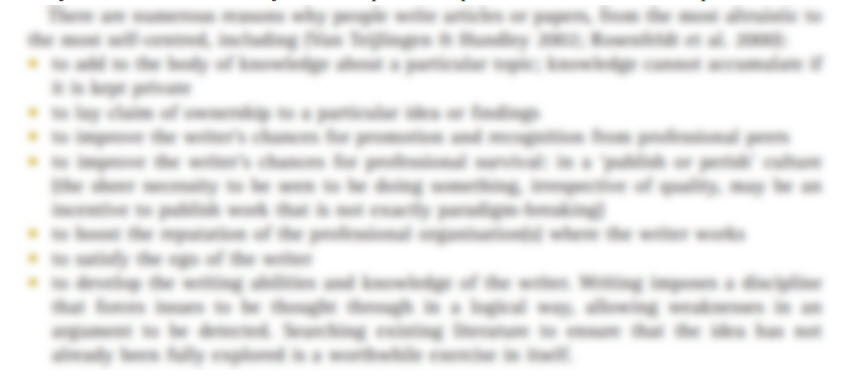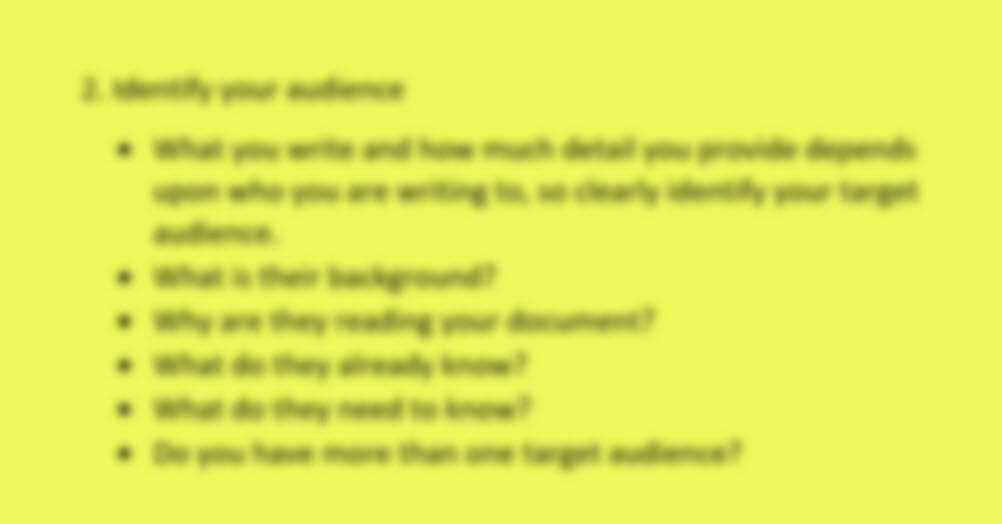Have you ever had problems when co-authoring a document?
Are you about to co-author a document but have not had a lot of experience of working with other authors? Have you worked with other authors who avoid replying to your emails, contribute little to the document, then expect to be included as an author? Have you sat down with your co-authors and decided who will do what task, then find that one author has taken charge of the writing project? Have you had disputes about who should be the lead author of your paper? These problems reflect a lack of planning: co-authors should define their roles and responsibilities before they start writing.
Being an author of a published scientific document brings responsibilities: you are acknowledged as having written and designed that document and you may need to verify or defend your writing.
If you are the author of a document presenting original research you are presenting yourself as the person responsible for designing and completing the study and you will be given credit for any original ideas, new findings and conclusions. You are responsible for verifying the integrity of your work. If there is more than one author, the credit and responsibility is assigned equally to all authors, even with the understanding that the first author is often the major contributor.
When co-authoring a document, each author will complete different tasks. The amount and type of work completed by each author will vary according to the nature of the project, the topic, the industry’s or discipline’s conventions and the number of co-authors.
Should each author's contribution be listed in the document?
Whether or not the contributions of all co-authors are included in the document itself, will depend upon the type and purpose of the document. For example, with a short, three-page report prepared by a company for a client, it might not be appropriate to state who the authors are, let alone outlining what their contributions were. In some instances, outlining co-authors contributions is essential. When submitting an article for a peer-reviewed journal, it is usually a requirement that co-authors meticulously outline their contribution to the document. For example, the ICMJE (International Committee of Medical Journal Editors) state “In addition to being accountable for the parts of the work he or she has done, an author should be able to identify which co-authors are responsible for specific other parts of the work. In addition, authors should have confidence in the integrity of the contributions of their co-authors.”
Co-authoring is often unplanned
In many instances, the contributions of co-authors are not documented or even formally agreed to; a group of co-authors might discuss allocation of tasks over a coffee in an informal meeting or through short emails. In many instances, there is no prior agreement between co-authors at all which can lead to significant problems.
If the role and responsibilities of co-authors are not managed effectively, the process of writing can take longer than it should, or worse, documents may be poorly written or never get completed. Confusion about who does what can cause disagreement between authors and dramatically reduce the quality and quantity of what is written. Additional problems include:
- disputes over who is in charge of the writing project, who has the final say about the content or conclusions or who is the lead author
- unrealistic expectations by a writer being nominated as author when they have made an insignificant contribution
- objections by a colleague being nominated as an author when they consider their contribution to be minimal, preferring instead to be mentioned in the acknowledgements.
- unnecessary duplication of writing, editing and analysis tasks
- insufficient completion of essential tasks that is either not recognised at all or completed at the last minute without sufficient quality control
- ad-hoc invitations for other writers to contribute at different stages
Irrespective of the type of document produced, each co-author should outline their proposed contribution in separate document before they start writing. This is necessary for a well-managed project, as the role of authors can often change during the process of drafting of a document and written agreements are easier to manage than verbal agreements. An authorship agreement document can be updated if there are any changes and modified for different project. An example is the Authorship Agreement template from Southern Cross University.
Steps in developing a Co-author Agreement:
1. Refer to a published authorship policy for guidance
An authorship policy outlines what contributions are necessary for someone to be considered an author of a document. Most universities have authorship policies (e.g. UTAS), as do publishing companies, editorial committees and research institutions. The Australian Code for the Responsible Conduct of Research (2007) section on Authorship (5.1) states: …“To be named as an author, a researcher must have made a substantial scholarly contribution to the work and be able to take responsibility for at least that part of the work they contributed. Attribution of authorship depends to some extent on the discipline, but in all cases, authorship must be based on substantial contributions in a combination of:
- conception and design of the project
- analysis and interpretation of research data
- drafting significant parts of the work or critically revising it so as to contribute to the
- interpretation.”
2. Identify what contributions are necessary before assigning tasks to authors
If there is no lead author who is in charge of the writing project, as a group, co-authors should decide what contributions are necessary before assigning, or agreeing to tasks. This will ensure essential tasks are not overlooked and may prevent additional, unnecessary tasks (i.e. the preparation of 12 images for publication when one will suffice).
3. Draft an Co-author Agreement document
Draft an Co-author Agreement document that outlines each author's role, responsibilities and contributions to the document. This can also include timelines for completion. Send the draft to all co-authors for comment and feedback.
4. Finalise Co-author Agreement document
Once all authors have agreed to the outline, finalise the agreement and return to all authors. Once the contributions of each co-author are assigned and agreed to, then the writing can commence. If co-authors maintain regular communication while preparing the document, any changes to contributions can be further monitored.
The final Co-author Agreement document can also be developed as a template for future projects
© Dr Marina Hurley 2022 www.writingclearscience.com.au
Any suggestions or comments please email admin@writingclearscience.com.au
Find out more about our new online course...
Now includes feedback on your writing Learn more...
SUBSCRIBE to the Writing Clear Science Newsletter
to keep informed about our latest blogs, webinars and writing courses.
FURTHER READING
- Should we use active or passive voice?
- 10 writing tips for the struggling ESL science writer
- Co-authors should define their roles and responsibilities before they start writing
- How to write when you don’t feel like it
- When to cite and when not to
- Back to basics: science knowledge is gained while information is produced
- How to build and maintain confidence as a writer
- If science was perfect, it wouldn’t be science
- The essentials of science writing: What is science writing?
- 8 steps to writing your first draft
- Two ways to be an inefficient writer
- Work-procrastination: important stuff that keeps us from writing
















